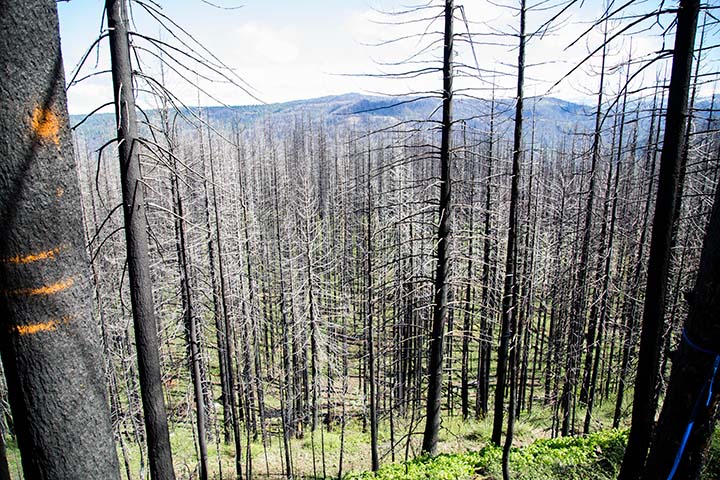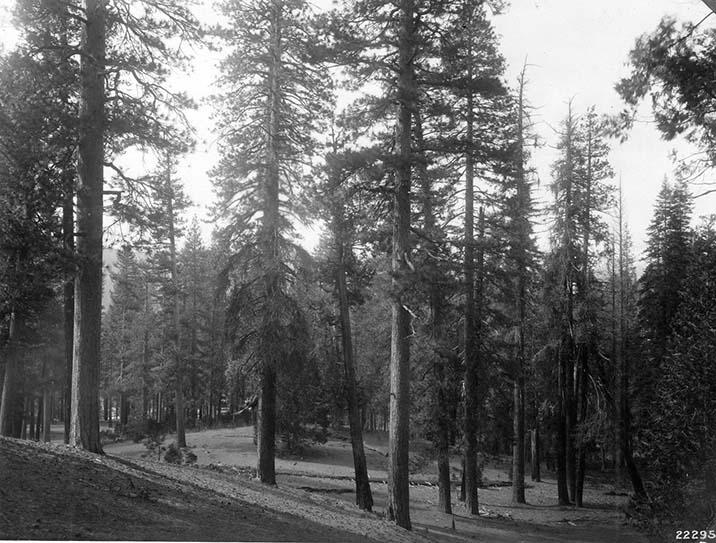
Remnants of the 2014 King Fire, which started near Pollock Pines to the east of Sacramento, as pictured in 2016. The dense composition of contemporary forests make them more prone to high-intensity fire.
New findings from a team of UC Berkeley researchers recommend that California policymakers reconsider the idea of what a “resilient” forest looks like or risk jeopardizing the state’s ambitious greenhouse gas reduction goals.
Rather than maintain denser contemporary forests, the researchers suggest building a new model of forest “resiliency” informed by historic composition and projected changes to climate. The findings were published last Friday in Environmental Research Letters and have strong implications for California’s long-term carbon policy.
“If California wants to continue to be a leader in climate policy, then policymakers and land managers need to start having an honest conversation about the inherent conflicts between sustaining forests and storing carbon,” said Alexis Bernal, a research assistant in the lab of ESPM professor Scott Stephens and corresponding author for the study.
The Sierra Nevada and southern Cascade mountains have been essential to California’s carbon policy proposals for decades. They currently store close to half of California’s captured carbon and will likely play an outsize role in reducing emissions to 40% below 1990 levels by 2030—a target set by state lawmakers in 2017 when they voted to extend the state’s cap and trade program.
But between 2018 and 2019, forests in the region lost 1.1 million metric tons of stored carbon to drought, wildfire, and invasive pests. That loss represents a 35% decrease in stored carbon and calls into question the feasibility of California’s long-term carbon policy.
Stephens, professor of fire science and ecology and co-author of the study, worries that climate change and existing forest management practices will only exacerbate this continued decline in stored carbon. The paper estimates that forests in the region would need a 75% reduction in density (and, by extension, stored carbon) to be considered resilient given climate projections for 2069.
“We knew from dozens of previous studies that there is a strong disparity between current and historical forest densities, but what is shocking about these results is how drastic that disparity gets when you project what historical forests would look like under future climate,” said co-author Brandon Collins, an adjunct professor with UC Berkeley and a research scientist with the U.S. Forest Service.

A 1914 photo of a mixed conifer forest in the Sierra Nevada region.
Historically, forests in the Sierra Nevada and southern Cascade region looked shockingly different than they do today: they were dominated by pine species, had lower overall tree density but larger average diameters, and less living organic matter (trees, plants, shrubs, etc.) occurring aboveground. Frequent lightning fire and Indigenous burning practices helped forests withstand large fires and widespread drought.
“Historical forests were more resilient to disturbances than forests are today,” Bernal explained. Contemporary forests are much denser and more homogeneous than before, she added, and are often filled with tree species (like firs) that promote high-intensity fires.
“It would make sense for us to want to try and mimic the structure and composition of our historical forests because they were created and maintained by disturbances,” Bernal said, “so restoring these conditions in contemporary forests could promote resiliency to future disturbances under climate change.”
The team reviewed large-scale tree health and forest diversity datasets conducted between 1911 and 1936 to determine historic forest density and tree size. These inventories were combined with historic climate and topographic data—temperature, elevation, precipitation, and slope—and projected shifts in environmental conditions due to climate change.
“By taking these conditions and applying a climate change model, we can project what the new climate will be in our forests,” Stephens said. “Using these projections, we can then look for that climate envelope in our historic data and project that forest structure forward.”
The researchers hope that these estimates will help land managers and policymakers reconcile the disconnect between California’s forest management practices and carbon sequestration efforts, and better inform ongoing forest restoration efforts.
“It would take more stewardship, more prescribed burning, more proactive mechanical restoration treatments, and more managed wildfire in remote areas to keep fuel hazards down and maintain the ability of those forests to survive wildfire and other processes,” Stephens said, “but without intervention and maintenance, we will continue to experience terrible wildfires and their impacts.”
John Battles, a professor of forest ecology, also contributed to the study.
READ MORE
- Biomass stocks in California's fire-prone forests: mismatch in ecology and policy (Environmental Research Letters)
